A milestone for vegetarianism came in 1988, when the American Dietetic Association (ADA) published a position paper written by vegetarian dietitian Suzanne Havala. At last, the mainstream nutrition organization sanctioned the vegetarian diet as healthful. Havala is nutrition educator for Presbyterian Hospital in Charlotte, N.C., and is establishing a group of vegetarian dietitians within the ADA. This past summer, she worked with Cornell University researcher T. Colin Campbell to help compile data gathered for the China Health Project.
– “A Positive Position,” Vegetarian Times, Dec. 1990, p. 55
1988 paper title: “Vegetarian Diets – technical support paper”
Position statement: “It is the position of The American Dietetic Association that vegetarian diets are healthful and nutritionally adequate when appropriately planned.”
Authors
Primary: Suzanne Havala, R.D. (vegetarian for ethical and environmental reasons)
Secondary: Johanna Dwyer, D.SC., R.D. (non-vegetarian)
Reviewers
Phyllis Acosta Dr. P.H., R.D. (vegetarian Seventh-day Adventist)
George Eisman, R.D. (vegan for ethical, environmental and health reasons)
Alice Marsh, R.D. (vegetarian Seventh-day Adventist)
Connie Metcalf, R.D. (vegetarian at the time for environmental and health reasons)
Patricia Mutch, Ph.D., R.D. (vegetarian Seventh-day Adventist)
U. D. Register Ph.D., R.D. (vegetarian Seventh-day Adventist)
Kathleen Zolber, Ph.D., R.D. (vegetarian Seventh-day Adventist)
Comments about veganism from the paper:
Although it is still speculative, the dietary differences, especially in vegans, may produce physiological changes that may inhibit the causal chain for colon cancer. …
Vegetarians, especially vegans, have weights that are closer to desirable weights than do nonvegetarians. Several factors may be involved, including moderation in energy intakes, increased physical activity, and better regulation of food intake. The high-carbohydrate, low-fat vegetarian diet, in combination with exercise, may decrease the risk of obesity. …
In countries where sanitary conditions are poor, contamination of foods with microbes and organisms that produce the vitamin may contribute all that is needed. In Western countries, however, where sanitary practices are better, the risk of vitamin B-12 deficiency is greater. Vegans must include a reliable source of vitamin B-12 in their diets or be at risk of eventually developing a deficiency.
Infants and children who consume well-planned vegetarian diets including milk products or eggs can generally meet all of their nutritional requirements for growth. Those who follow vegan or vegan-like diets which include no animal products can be healthy, but more care must be taken to ensure adequacy. Vitamin D and iron supplements, in addition to vitamin B-12 at levels sufficient to meet the Recommended Dietary Allowances, may need to be provided. …
Vegan diets tend to be high in bulk, which makes it more challenging to meet energy needs, especially for infants, children and adolescents.
What Vegetarian Times said about this position paper:
In the last two decades, the American Dietetic Association’s position on vegetarianism has changed from skepticism to cautious acceptance to something approaching advocacy—or at least a recommendation that Americans move away from the standard meat-centered diet to a more vegetarian one.
The ADA’s most recent position paper on the subject, adopted last October and published in the March 1988 edition of the Journal of the American Dietetic Association, says well-planned vegetarian meals promote health and are nutritionally sound. It states: “A considerable body of scientific data suggest positive relationships between vegetarian lifestyles and risk reduction for several chronic degenerative diseases, such as obesity, coronary artery disease, hypertension, diabetes mellitus, colon cancer, and others.”
The position paper emphasizes that vegetarian diets must be well planned (standard ADA advice for non-vegetarians as well), but it backs off somewhat from the overcautious stance of a position paper published in 1980. That earlier paper endorsed the concept of “protein complementarity,” or eating a variety of protein dishes at the same meal so that the total amino acid content resembled that of meat. The new paper, while repeating that a mixture of proteins from unrefined grains, legumes, seeds, nuts and vegetables is desirable, says that “it is not necessary that complementation of amino acid profiles be precise and at exactly the same meal… .This theory urged conscious combining of proteins at every meal with the caveat that malnutrition would ensue if this was not done within a strict time interval.”
However, the 1988 paper includes warnings to vegans that some plant foods advertised as containing vitamin B12, including tempeh, may actually contain mostly inactive B12 analogs. Vegans should include a reliable B12 source in their diets, the association says—either supplements or fortified foods.
The 1988 ADA paper is also more upfront than its predecessor regarding the health benefits of vegetarianism. Although the 1980 paper said only that “a growing body of scientific evidence supports a positive relationship between the consumption of a plant-based diet and the prevention of certain diseases,” the new position is stronger and more specific, saying that fewer vegetarians die from heart disease and colon cancer, and that they are at lower risk for diabetes, high blood pressure and osteoporosis, among other degenerative diseases.
Though the ADA is changing its attitude about vegetarianism, it will take some time before word trickles down to practicing physicians. Nutrition textbooks used in medical schools still contain dated information about protein complementarity and the alleged “health risks” of vegetarianism, and some doctors simply don’t keep up on the most current thinking in fields other than their own. Vegetarians whose doctors don’t support their diet may want to take the initiative in bringing the ADA endorsement to their doctors’ attention.
– “Taking a Favorable Position,” Drew DeSilver, Vegetarian Times, May 1988, p. 26
It is unclear how all of the authors and reviewers for the 1988 paper were selected, but the Adventist contingent (Acosta, Register, Zolber, Mutch and Marsh) had been acquainted for years before reviewing the paper. Zolber and Register both worked at California’s Loma Linda University and collaborated on dietetic projects together. Acosta was an associate professor in nutrition at Loma Linda University when Zolber and Register were there, and worked with them on the Seventh-day Adventist Dietetic Association’s Everyday Nutrition for Your Family. Marsh and Mutch were friends and both worked at the Adventist-run Andrews University in Michigan. Bridging the California-Michigan divide, Zolber and Register met up with Mutch and Marsh at a meeting of Seventh-day Adventist dietitians in Kansas City in May, 1975. (“General Conference Committee minutes for March, 1975”)
Four years later, Register, Mutch and Marsh were members of a committee that adopted a statement resolving that Adventists should promote a vegetarian rather than a vegan diet because of what their prophet Ellen G. White had written:
The General Conference Nutrition Advisory Committee met at Shawnee Mission Medical Center in Kansas City, January 24-26, to discuss many items of interest, such as the latest information regarding the relationship of diet and cancer, the reports of recent research, and other nutrition information.
Members of this committee are: U. D. Register, James Blankenship, and Irma Vhymeister, from the Department of Nutrition, School of Health, Loma Linda University; Alice Marsh, Patricia Mutch, and Fonda Chaffee, from the Department of Home Economics, Andrews University; Rose Stoia, president of the Seventh-day Adventist Dietetics Association; Oliver Miller, nutritionist of Loma Linda Foods; Alien Buller, of Worthington Foods, Inc.; John Scharffenberg, M.D.; Samuel DeShay, Albert Whiting, Wayne McFarland, and Ella May Stoneburner, from the General Conference Health Department; Robert Olson, from the Ellen G. White Estate; and Francis W. Wernick, a general vice-president of the General Conference. Counsel from this committee about the use of dairy products and eggs is as follows:
Although the time will come when there will be no safety in using dairy products or eggs (Counsels on Diet and Foods, p. 356), and people everywhere should be taught how to cook without milk and eggs (ibid., p. 470), cautions were given not totally to discontinue using these items until the circumstances demanded it (ibid., p. 208). The counsel is that “reforms which belong to the future must not be brought into the present. We are to advance step by step. Reforms are not to be brought in as innovations, but as natural consequences. Then they will be great blessings."—Ellen G. White, letter 98, 1901. It is not believed that the time is here in which the "strictest diet"—without milk and eggs—is to be promoted. The primary point to remember is that this need not be a major issue, since this whole question will "work out its own problem” (Counsels on Diet and Foods, p. 206).
– “Nutritionists adopt statement on diet,” Adventist Review, May 3, 1979, p. 17
Of the nine authors and reviewers of the ADA’s 1988 vegetarian position paper, six took part in Loma Linda University’s First International Congress on Vegetarian Nutrition in 1987: Johanna Dwyer, Kathleen Keen Zolber, U.D. Register, Patricia Mutch, Alice Marsh and Phyllis Acosta. Loma Linda is a Seventh-day Adventist university, which may be why the Congress was heavily focused on Adventist themes. An Adventist writer summed up the First International Congress on Vegetarian Nutrition a few months later:
At the congress no one disputed that Seventh-day Adventists have longer life expectancies than the general population. … While many researchers identified vegetarianism as the reason, others suggested that in addition, the Adventist lifestyle might account for the longer life expectancies. …
The goal of the convention organizers was to share with other professionals scientific and research support for the Seventh-day Adventist health principles—something they accomplished very satisfactorily.
Cosponsors included: Loma Linda University Medical Center, Adventist Health System/United States, Seventh-day Adventist Hospital Associations, San Joaquin Community [Adventist] Health Center, Loma Linda University, Andrews University, Departments of Health of the North American and South Pacific Divisions of Seventh-day Adventists, Seventh-day Adventist Dietetic Association. Corporate donors included: S.E. Rykoff/Sexton, Worthington Foods, Inc., Loma Linda Foods, Sanitarium Foods.
– “Vegetarianism at the Scientific Frontier,” Berryl Longway, Spectrum, Aug., 1987, pp. 53-54
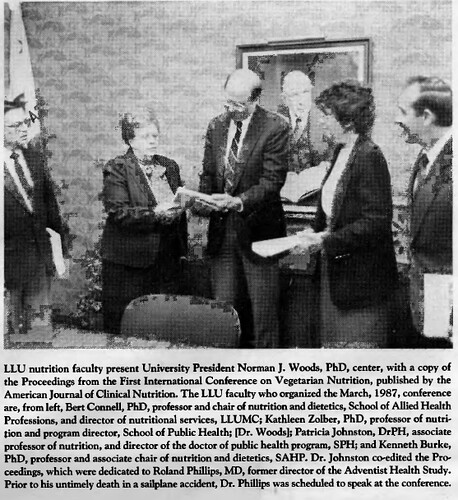
Johanna Dwyer, secondary author of the 1988 and 1993 ADA position papers on a vegetarian diet, gave the keynote address at The First International Congress on Vegetarian Nutrition.
Johanna Dwyer: Secondary author for the ADA’s 1988 and 1993 position papers on a vegetarian diet, reviewer for the 1997 paper, and content advisor for the Association Positions Committee Workgroup for the 2009 paper; non-vegetarian
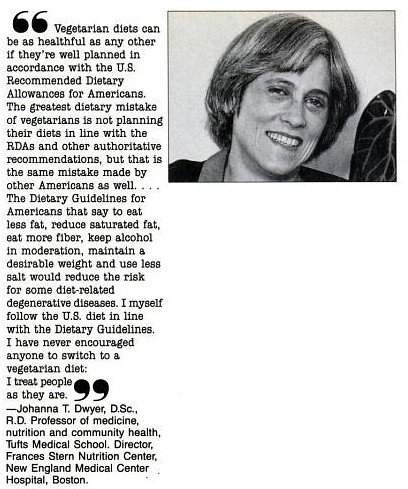
Johanna Dwyer is the only non-vegetarian to have co-authored any of the American Dietetic Association’s position papers on a vegetarian diet. Primary author Suzanne Havala Hobbs told me that Dwyer being the secondary author meant that Havala drafted the outlines and wrote the first drafts of the papers, Dwyer went over them and suggested edits, and then they went back and forth until they could agree on the content.
The ADA’s 1988 vegetarian position paper cited Dwyer’s paper “Nutrition status and alternative lifestyle diets with special reference to vegetarianism in the USA,” CRC Handbook of Nutritional Supplements. Vol. 1. Human Use. Boca Raton, FL: CRC Press, 1983, pp. 343-410. The ADA’s 1997 vegetarian position paper cited Dwyer’s paper, “Health aspects of vegetarian diets,” Am J Clin Nutr September 1988 vol. 48 no. 3 712-738.
Dwyer’s research into vegetarian nutrition led her to take a mixed approach –- positive, but with reservations. She expressed more qualms with veganism.
Johanna Dwyer on the Nutritional Benefits and Drawbacks of Vegetarian and Vegan Diets
Few, if any, problems are associated with feeding young children a vegetarian diet that includes milk and eggs, Dwyer said, but a strict vegan diet can be risky unless it is carefully planned and includes fortified soy milk or vitamin-mineral supplements.
– “Extreme vegetarian diet can impair children’s health,” Jane E. Brody, The New York Times News Service, Times-News, Apr. 1, 1987, p. 4B
* * *
Delivering the keynote address [at the First International Congress on Vegetarian Nutrition], Johanna Dwyer, D.Sc., R.D., Tufts University and Frances Stern Nutrition Center, Boston, said that evidence for the healthfulness of a well-planned vegetarian diet is substantial and that those vegetarian diets in line with the U.S. Dietary Guidelines and the Recommended Dietary Allowances are appropriate to recommend. Dr. Dwyer stated that the nutritional status of vegetarians is “influenced by the type of vegetarian diet adopted, the extent to which it is planned to meet nutrient needs and the level of nutrient requirements as determined by physiological events and coexisting disease states, as well as patterns of utilization of health services, and other lifestyle factors.”
In studies of all-cause mortality, vegetarians’ mortality rates are consistently lower than those of nonvegetarians. Diet, social class and healthy lifestyles (including leanness, avoidance of tobacco, abstinence from alcohol and drugs and increased physical activity) probably account for this, Dr. Dwyer believes.
Unplanned vegetarian diets, on the other hand, may result in iron deficiency anemia, low bioavailability of calcium and other minerals, and, in vegans, megaloblastic anemia due to vitamin B12 deficiency and vitamin D deficiency rickets in infancy. As Dr. Dwyer pointed out in another paper, although children on strict vegan diets can grow and thrive if care is taken to meet nutrient needs, such children tend to be smaller than average.
– “Congress Investigates Vegetarian Nutrition,” Robert Kowalski, Patricia K. Johnston, Kenneth I. Burke, Harley Stanton, Nutrition Today, July/Aug. 1987, p. 30
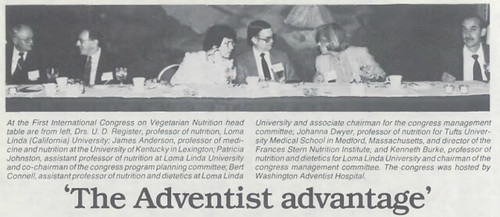
* * *
Dr. Johanna Dwyer, a nutrition expert at Tufts-New England Medical Center in Boston who studies the effects of vegetarian diets on children, said it is possible to meet the nutrient needs of a child on the vegan vegetarian diet, but “most people would need a lot of help to do it.”
– “Should children become strict vegetarians?” Judy Lueders, Southeast Missourian, July 8, 1988, p. 8B
* * *
Tufts University nutrition professor Johanna Dwyer, D.Sc., R.D., and dean of the school of veterinary medicine Franklin Loew, Ph.D., argue that a vegan diet is not suitable for all populations; they contend that without animal products, infants and toddlers may get too little energy and too much bulk, adolescent girls may consume insufficient calcium and the urban poor may fail to thrive because they have such limited access to fresh foods.
On the other side of the issue, nutritionists Reed Mangels, Ph.D., and Suzanne Havala, R.D., note that regardless of their diet, infants, children, adolescents, and pregnant and lactating women are at higher risk for nutritional deficiency and that “in many instances vegan diets offer health benefits.”
– “Can Everyone in the World Be Vegan?” Steve Lustgarden, Vegetarian Times, Sept. 1994, p. 20
* * *
For many American women, vegetarianism is a healthful choice. For others, it contributes significantly to ill health. …
Vegetarian eating presents particular challenges to women. The nutrient needs of women vary more than do those of men across the lifecycle because of altered requirements during adolescence, pregnancy, and lactation. Also, the nutrient density in women’s diets must be greater than in men’s, because women need less food (or, to be more exact, fewer calories) although their needs for specific nutrients are often the same or higher. …
These issues of nutrient density and nutrient sufficiency may present real risks with unplanned vegan diets (although they rarely become limiting on lacto-ovo-vegetarian diets). Therefore, careful dietary planning is important for vegetarian women and mandatory for vegan women.
– “Vegetarianism for Women,” Johanna T. Dwyer, Nutrition in Women’s Health, 1996, pp. 232 & 234
* * *
Diets that are predominantly based on plant food are generally moderate in calories and protein, lower in total fat, saturated fat, and cholesterol, and higher in polyunsaturated fatty acids than most animal foods. Plant-food diets are also higher in dietary fiber, magnesium, folic acid, antioxidant nutrients such as vitamin E, vitamin C, and the carotenoids, and possibly other biologically active substances (eg, phytoestrogens) that may have beneficial dietary effects. Many vegetarians also avoid alcohol, smoking, sedentary lifestyles, caffeine-containing foods, spices, highly refined and processed foods, and stressful situations. Some, but probably not all, of these practices also promote overall health.
Vegetarian diets also possess disadvantages. If all animal foods are avoided, vitamin B-12 intakes are unlikely to be adequate unless foods fortified with vitamin B-12 or vitamin supplements are used. Because folic acid intakes are usually high in vegetarian diets, megaloblastic anemia that is due to vitamin B-12 deficiency may be masked in vegans, increasing the risk that the deficiency will remain undetected. Vitamin D deficiency may arise in vegans or other vegetarians who omit from their diet vitamin D-fortified milk and milk products, or vitamin D-fortified soy formulas or milks, particularly during the growing years. From a practical standpoint in Western countries, protein quality is rarely a problem if energy intakes are adequate and complementary plant proteins are selected. However, plant proteins are rarely complete in themselves. Naturally occurring plant sources of calcium, iron, and zinc are less highly bioavailable than the same sources in animal foods. Vegetarian diets and high fiber intakes are often associated with high levels of oxalates and phytates, which may reduce the absorption and bioavailability of iron, calcium, and zinc.
– “Vegetarian eating patterns: science, values, and food choices—where do we go from here?” Johanna T Dwyer, AM J Clin Nutr 1994;59(suppl):1255S-62S, pp. 1256S-1257S & 1260S
* * *
A prominent child behavior specialist with Boston City Hospital, Brazelton adamantly insisted that meat and dairy are critical for childhood development. Michael Georgiess, M.D., professor of pediatrics and child development at the University of Minnesota in Minneapolis echoed that sentiment, warning that vegetarian kids faced “very significant risks.” Johanna Dwyer, a nutrition expert at Tufts-New England Medical Center in Boston, added, “We should be sticking to dietary changes that have demonstratable health benefits, like those outlined in the [U.S. Department of Agriculture’s] food pyramid.“
– “Into the Mouths of Babes,” Norine Dworkin, Vegetarian Times, Sept. 1998, p. 72
* * *
While no one disputes that the more vegetables in a child’s diet, the better, some nutritionists are less enthusiastic about the stricter vegan diet.
”I do think it’s risky for kids unless it’s done with a great deal of care and due regard for the special needs of children,” says Johanna Dwyer, director of the renowned Frances Stern Nutrition Center at Tufts-New England Medical Center in Boston. “Particularly their nutrition needs for growth, specifically for vitamin B-12, calcium, Vitamin D, iron and zinc.”
– “What Parents Need to Know to Raise Healthy Vegetarian Kids,” Sarah Tomlinson, Parenthood.com
***
"We should be sticking to dietary changes that have demonstrable health benefits, like those outlined in the food pyramid,” said Dr. Johanna Dwyer, nutrition expert at Tufts-New England Medical Center in Boston who has studied the effects of vegetarian diets on growth and development. The food pyramid, a dietary guide developed by the United States Department of Agriculture, emphasizes grains, fruits and vegetables but also includes meats, poultry, fish and dairy products.
– “Final Advice From Dr. Spock: Eat Only All Your Vegetables,” Jane E. Brody, The New York Times, June 20, 1998
***
Suzanne Havala Hobbs: Primary author for the ADA’s 1988 and 1993 vegetarian position papers, reviewer for the 1997 paper and content advisor for the 2003 paper; vegetarian for environmental and ethical reasons
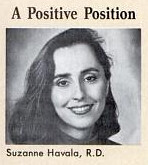
In 1986 we sent information for distribution at the American Dietetic Association (ADA) annual meeting. And our newest dietitian, Suzanne Havala, produced a “Guide to Vegetarian Weight Loss,” a “Hospital Survival Guide,” and “Osteoporosis: Beyond A Simple Answer.”
In 1987, VRG’s Nutrition Advisor, Suzanne Havala, was chosen to be the primary author of the ADA position paper on vegetarianism, which accomplished the following:
1) Put health advantages in perspective with health risks;
2) Abandoned the complementary protein myth;
3) Updated information on B12;
4) Set the record straight concerning vegetarians and calcium; and
5) Reiterated that the daily requirements for protein can be easily met in a vegetarian diet.The position paper increased health professionals’ acceptance of vegetarian eating patterns.
Suzanne Havala Hobbs went vegetarian at the age of 16 in 1976. She became a registered dietitian in 1981. A few years after that, she became the Nutrition Advisor for the Vegetarian Resource Group, a position she’s held for over 25 years. In an interview she said, “it was my work for VRG [the Vegetarian Resource Group] that led to my writing the 1988 and 1993 position papers on vegetarian diets for ADA…” (“Vegetarian Dietetics in Action,” Anita Crook, Vegetarian Nutrition Update, Spring 2001, p. 14)
Suzanne Havala on “Why Meatless Makes Sense”
When I was a little girl, my mother went vegetarian, so I was exposed to the idea from an early age. Later, I was a high school swimmer, and I read a book (Faith, Love, and Seaweed) in which Olympic gold medalist Murray Rose attributed his success in swimming to his vegetarian diet. This piqued my interest, and at 16 I switched to a vegetarian diet. It didn’t seem to affect my athletic abilities much, but it was a lifestyle change that stuck.
– “Vegetarian Dietetics in Action,” Anita Crook, Vegetarian Nutrition Update, Spring 2001, p. 14
* * *
When you choose a vegetarian lifestyle, you contribute to the health of the whole planet. … Animal Agriculture — raising animals for human use — places a heavy burden on the land. …
Livestock grazing causes desertification by eroding the topsoil and drying out the land, preventing it from supporting plant life. …
The appetite for meat and other animal products also consumes trees and forests, although these trees may not be the ones in your own backyard or your neighbor’s. …
[Aquifers] are dwindling rapidly because people are sucking up great quantities of the stuff to irrigate huge tracts of land to graze animals that provide a relatively small amount of food. What an inefficient use of a resource as precious as our fresh water!
Furthermore, animal agriculture is polluting both fresh water and saltwater. Pesticides, herbicides, and fertilizers used to grow feed for animals are contaminating water supplies, and nitrogenous fecal waste produced by animals washes into streams, rivers, lakes, and bays. …
Animal agriculture is ransacking our planet of fossil fuels. The production of meat, eggs, and dairy products requires intensive use of fossil fuels — including oil, coal, and natural gas — for everything from transporting animal feed and the animals themselves to running farm machinery and operating the factory-homes where animals are raised. Fossil fuels are also used to make synthetic fertilizers used on factory farms. …
When you adopt a vegetarian diet, you also help to diminish the pain and suffering of those without a voice. …
Some Christians…interpret the passage Genesis 1:29 from the Old Testament to mean that humans should eat a vegetarian diet: “And God said, behold, I have given you every herb-bearing seed, which is upon the face of all the earth, and every tree, in which is the fruit of a tree yielding seed; to you it shall be for meat.” …
If you share your life with dogs or cats, you know that animals have feelings. You probably also know that cattle, chickens, and pigs don’t live in idyllic pastures and barnyards anymore. They live and die in factory farms and slaughterhouses, the likes of which would rival any horror movie.
– Living Vegetarian for Dummies, Suzanne Havala Hobbs, pp. 31-34
* * *
The old adage about getting too much of a good thing holds true with protein. People should get 10 percent to 15 percent of their calories from fat, 10 percent to 15 percent from protein and the rest from carbohydrates, recommends [Suzanne] Havala.
– “Pumped Up on Protein?” Karen Springen, Vegetarian Times, Aug. 1993, p. 24
Since most of the quotes I found from Havala were from after 1988, I’ll include more in the 1993 entry.
Phyllis B. Acosta: Reviewer for the ADA’s 1988 and 1993 position papers on a vegetarian diet; Seventh-day Adventist vegetarian
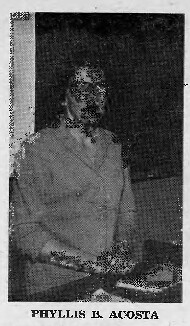
Phyllis Brown Acosta was a member of the Seventh-day Adventist Dietetic Association and a contributor to Everyday Nutrition for Your Family, a book the SDADA published in 1961. She also wrote the 1971 edition of the SDADA’s Diet Manual: Utilizing a Vegetarian Diet Plan. She was associate professor of the College of Medical Evangelists/Loma Linda University School of Nutrition and Dietetics from 1960-64, and director of dietary service at Adventist-run White Memorial Hospital, 1962-64. The Adventist-run Andrews University named Acosta an honored alumnus in 1985.
One of Acosta’s main research interests was Phenylketonuria, a genetic disorder that often requires a meat-free diet. But she studied more general subjects of interest to vegans and vegetarians too, including whether unsupplemented vegan foods provided vitamin B12:
Unpasteurized misos were found to have the highest B12 content, averaging 0.21 μg/ 100g. Vitamin B12 activity in miso ranged from a high of 0.25 μg/ 100g in barley miso to a low of 0.15 μg/100g in light rice miso. Pasteurized tempeh contained 0.12 μg vitamin B12 per 100g food. Tempeh burger contained 0.06 to 0.11 μg vitamin B12 per 100g food. The variation in vitamin B12 activity found in these products may be due to different conditions used or produced during fermentation. Collaborative studies are needed and assessment of vitamin B12 pseudoform activity before these foods can be considered a source of vitamin B12.
– “Vitamin B12 Activity in Miso and Tempeh,” Delores D. Truesdell, Nancy R. Green, Phyllis B. Acosta, Journal of Food Science, Mar. 1987, pp. 493-494
At Loma Linda University’s First International Congress on Vegetarian Nutrition, Acosta discussed her findings on “Availability of essential amino acids and nitrogen in vegan diets.” The abstract of her study read:
Vegan children often fail to grow as well as their omnivorous cohorts despite protein intakes that exceed RDA. Explanations for inadequate growth include deficiencies of energy, calcium, zinc and vitamins B-12 and D. Due to decreased bioavailability, amino acids and nitrogen in vegan diets may be inadequate to support normal growth. Bioavailability of amino acids and nitrogen may be decreased by dietary fiber, food processing and storage, inadequate energy, and other unknown factors. Bioavailability should be considered when evaluating adequacy of intakes of protein, amino acids and nitrogen from vegan diets by infants and children.
– “Availability of essential amino acids and nitrogen in vegan diets,” Phyllis B Acosta, AM J Clin Nutr 1988;48:868.
The ADA’s 1988 vegetarian position paper cited Acosta’s paper “Feeding the vegan infant and child,” J Am Diet Assoc. 1985 Jul;85(7):837-40.
George Eisman: Reviewer for the ADA’s 1988 position paper on a vegetarian diet; vegan for ethical, environmental and health reasons

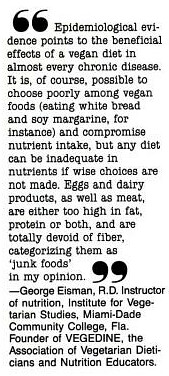
George Eisman became vegetarian in 1970. He qualified as a registered dietitian in 1978, and went vegan in 1982. In the late 1980s, he founded the Vegetarian Studies program at Miami Dade Community College. Regarding this, Vegetarian Times reported:
Some of the courses to be offered under the program are “Cancer Prevention through Diet,” "Nutrition for Athletes,” “Vegetarianism for Beginners,” “Helping End World Hunger…In Your Own Kitchen,” and “Vegan Eating.”
The program will be coordinated by George Eisman, R.D., founder of Vegedine, a professional vegetarian dietitian organization. Prospective faculty members include Michael Klaper, M.D., who specializes in nutrition counseling, and Brother Ron Picarsky, a vegan chef who has won medals at the World Culinary Olympics.
– “Vegetarian Studies,” Vegetarian Times, Sept., 1986, p. 59
The Miami News added:
Eisman touts the [vegetarian] diet as a preventative measure against heart disease, cancer, osteoporosis and high blood pressure.
– “Learning Vegetarianism,” The Miami News, Sep. 10, 1987, 1D
Eisman is the founder and president of the Vegetarian & Vegan Foundation in New York and served on the Executive Board of Nalith, a group that promotes animal rights. He is an Advisory Board Member of EarthSave International.
He also founded Vegetarian Dietitians and Nutrition Educators (VEGEDINE), an association of vegetarian dietitians that existed before the American Dietetic Association’s Vegetarian Nutrition Dietetic Practice Group. But he helped bring the latter into being, which was formed on June 1, 1991, with Suzanne Havala as chairperson.
Eisman regularly speaks for events such the Animal Rights National Conference, Vegetarian Summerfest, Southeastern Compassion for Animals Action Symposium, the Compassionate Living Festival, Farm Sanctuary’s Veg for Life campaign and NYC’s Veggie Pride Parade, with lecture titles like “Promoting Vegetarianism as a Global Warming Solution” and “The Link Between Dairy/Animal Foods & Cancer Risk.” He was inducted into the North American Vegetarian Hall of Fame in 1993.
Eisman is the author of A Basic Course in Vegetarian and Vegan Nutrition, as well as The Most Noble Diet. Matt Ball, Vegan Outreach co-founder, co-authored the second edition of The Most Noble Diet.
Eisman is currently the nutrition director of The Coalition for Cancer Prevention through Plant-Based Eating.
George Eisman on food nutrition and ethics
[Eisman] had become a vegetarian during college and later transitioned to vegan after attending a Vegetarian Summerfest sparked his interest in a dairy- and egg-free diet. … Today, he is leading even more college students to vegetarianism through his nutrition courses. ….
”The demand for such education is growing, especially concerning veganism,” he says.
In addition to the academic platform he has created, George spreads the word about vegetarian nutrition through his prolific writings and appearances. …
George Eisman never tires of sharing his knowledge about vegetarian nutrition with others, whether in a more formal classroom setting or during a casual conversation.
”Each person provides a teaching opportunity,” he states. …
For those considering incorporating veganism into their own career paths, he advises them not to fear.
”Be ethical, and stay with it!” he encourages.
– “Vegetarian Nutrition Education Pioneer George Eisman,” Ed Coffin, Vegetarian Journal, Issue Two, 2009
* * *
This is not the kind of book you’d expect [to] find authored by a registered dietitian. No food exchanges or weekly meal plans here. In fact, George Eisman gives eating for health a rather low score as a reason for choosing foods. That’s not to say he considers nutrition unimportant, however; his diet recommendations are certainly healthy.
According to Eisman, though, it is not enough to strive for individual health. Global health must be the ultimate reason for eating what we do. By looking at what the whole planet needs when making food choices, he argues convincingly, nutritious and economic individual food choices will evolve naturally.
In a way, this work sets out a modified macrobiotic philosophy. Like Kushi and Osahwa, Eisman recognizes a universal order of which foods and eating are just a part. But the macrobiotics speak of a harmony resulting from opposite universal forces, while Eisman’s harmony is based on mankind’s conscious compassion.
There are similar elements to the two philosophies, though. Both argue eloquently that choosing foods in accordance with a higher world order will yield a diet that is harmonious and nutritious for the body—right down to the RDA for calcium. Both also recommend food choices which are local, unrefined and in season. The Most Noble Diet, however, takes into account very tangible social, economic, environmental and moral issues, solidly setting the book apart from “classical” macrobiotics. Eisman’s philosophy is certainly not new. It is the stuff of which “ethical vegetarianism” is made.
– “The Most Noble Diet,” Sally Hayhow, Vegetarian Times, Oct. 1984, p. 60
* * *
We liked the talk by George Eisman, R.D., chair-elect of the recently formed Vegetarian Nutrition Dietetic Practice Group of the American Dietetic Association. He said that the ever-conservative ADA had decreed the VN DPG would be disbanded if it did not attract at least 150 members in its first year of existence. It was amusing to hear that today, only eight months later, it has 1500 members. George also mentioned that half of the current undergraduates in the Cornell University nutrition department are vegetarians, and Cornell has the largest nutrition department of any school in the United States!
So rest assured that our important message is being heard across the country and around the world. Health educators, environmentalists and animal rights activists are coming together to teach people a better way to live. We know how to help humans, animals, and the planet; we know that health and non-violence begin with the fork.
– “President’s Message,” Elaine French, Vegetarian Society of Honolulu Newsletter, Sept. 1992
* * *
The human need for protein is about 15 – 20 grams a day. The average size adult woman needs about 15 grams a day to maintain her muscle tissue and so on. The average adult man needs about 20 grams a day. Now there’s 28 grams in an ounce. So it’s actually less than an ounce of protein that all adults need. …
The idea that beans and meat are equivalent sources of protein, it’s a no brainer when you explain to kids that meat has this stuff in it called cholesterol that clogs up our arteries, and beans have this stuff in it called fiber which we all need more of because we have all these digestive problems. That meat has no fiber, has lots of cholesterol. Beans have no cholesterol, lots of fiber. Which is a better place to get your protein? Like that, they say “beans.”
– “Nourishing Activism: Benefits and Concerns of a Vegan Diet for Humans and Animals,” George Eisman, speech at the Animal Rights 2010 National Conference
* * *
But I’m going to talk a little bit more about some of the other reasons why this dietitian doesn’t use dairy products. And they have to do with the same reasons why all of us, or most of us, don’t use meat products. Because we don’t want to see animals suffer, we don’t want to see the environment harmed, we don’t want to do damage to our bodies, and we don’t want to take food away from hungry people in the world. All of those things apply to dairy products as easily as they do to any meat products. The life of a dairy cow in this country is probably the worst thing that we could imagine doing to a fellow animal.
– “George Eisman RD on dairy, madcow, factory farming, health, vegan,” YouTube, uploaded Aug. 16, 2010
* * *
Vegan Mainstream: How did you get your start as a vegetarian nutritionist?
George Eisman: Concern for world hunger issues. It takes 15 pounds of grain to produce one pound of meat. It’s a greedy thing to insist on a meat-centered diet when so many go hungry.
VM: Who are some of the collaborators you’ve worked with doing research about plant-based nutrition? Any heroes?
GE: Dr. Kerrie Saunders, Gene Baur, T. Colin Campbell, Caldwell Esselstyn, Michael Greger, Michael Klaper.
VM: Wherein, in your opinion, lies common ground when speaking to people opposed to giving up meat? How do you approach the conversation when speaking?
GE: Most people care about animals, they just see the abuse and slaughter as “a necessary evil” because they believe they need animal products. These foods are not necessary for an adequate diet. Therefore the abuse and killing is just…evil.
VM: Discuss some common myths regarding cancer prevention?
GE: That just eating some healthy foods like blueberries, sweet potatoes, turmeric, etc. is enough. It certainly can help but without eliminating the hormone-laden animal products it’s less than a half-way measure.
– “Feature Interview: George Eisman on Cancer Prevention and Veganism,” Jessi Stafford, Vegan Mainstream, Dec. 16, 2011
Alice Marsh: Reviewer for the ADA’s 1988 vegetarian position paper; Seventh-day Adventist vegetarian
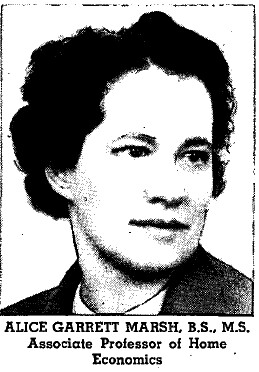
Dr. Marsh has served the church 36 years as a dietitian and teacher of home economics. She specialized in nutrition and earned registered dietitian status in 1932. She has been on the [Emmanuel Missionary College/Andrews University] faculty since 1950.
She has conducted several major research projects at the University of Nebraska and Andrews University, and the publishing of her research in human nutrition in several major journals has contributed to a fuller understanding of a subject of special interest to Seventh-day Adventists.
Dr. Marsh has been instrumental in conducting a number of community nutrition courses, and more than 500 persons who have attended her classes have been awarded the General Conference Certificate of Lay Nutrition Instructor.
– “General Conference Honors Three Andrews Professors,” Review and Herald, Sept. 5, 1974, p. 22
Alice Marsh’s first foray into Adventist nutrition work was as a dietitian for the Adventist-run Hinsdale Sanitarium. In the 1950s, she became a teacher and researcher at Emmanuel Missionary College in Michigan, which was renamed Andrews University in 1959 -– two years before its sister school, The College of Medical Evangelists, was re-branded Loma Linda University.
Marsh was among the first set of officers chosen to lead the Seventh-day Adventist Dietetic Association when it formed in 1954. (She was named Associate Public Relations Officer.) The number one stated objective for the organization was, "To uphold by precept and example the principles of healthful living given to the denomination by the Spirit of Prophecy.” (“S.D.A. Dietetic Association Organized,” Paul S. Damazo, Atlantic Union Gleaner, Dec. 20, 1954, p.2)
Alice Marsh was President of the Seventh-day Adventist Dietetic Association in 1968. She also contributed to the Seventh-day Adventist Dietetic Association publications About Nutrition and Everyday Nutrition for Your Family.
Marsh appeared to have been something of a mentor to Patricia Mutch, another Adventist who reviewed the 1988 ADA Vegetarian Position paper. While Mutch was an undergrad student, Marsh lured her to Andrews University by promising her a research position on “Operation Nutrinaut,” Marsh’s project that involved testing the bodily secretions of teenage girls fed lacto-ovo vegetarian diets.
In September of 1981, the SDADA awarded Marsh and Kathleen Zolber Distinguished Service awards.
Andrews University now offers the “The Frank L. and Alice G. Marsh Scholarship” to dietetic students.
The 1988 ADA vegetarian position paper cited Marsh’s paper, "Cortical bone density of adult lactoovovegetarians and omnivorous women,” J Am Diet Assoc 76:148, 1980. The 1993 ADA vegetarian position paper cited Marsh’s paper, “Vegetarian lifestyle and bone mineral density,” Am J Clin Nutr. 1988 Sep;48(3 Suppl):837-41. And the 2003 and 2009 ADA vegetarian position papers cited Marsh’s paper, “Nutrient similarities and differences of older lacto-ovo-vegetarian and omnivorous women,” Nutr Rep Int 1989;39:19–24.

Alice Marsh on Dietetics, Seventh-day Adventist Style
As Seventh-day Adventists we must hold close to the excellent dietary principles given us in the inspired writings of Ellen G. White. These are our road maps.
– “In Nutrition Are We Traveling Calf Paths or Superhighways?,” Alice G. Marsh, Review and Herald, Mar. 4, 1976, pp. 5-6
* * *
Modern nutrition can give no instruction that is more specific or that is more useful than the instruction this church has had for many years.
– “Sugars – Pro and Con,” Alice Garrett Marsh, The Review and Herald Nov. 14, 1957, p. 18
* * *
Following the General Conference Session, the International Nutrition Research Foundation of the Loma Linda Food Company at La Sierra sponsored a Nutrition and Food Service Convention (June 7-10, 1954) and invited people from the world field to attend. Room and board were free to attendees. Each day dietitians from hospitals and schools met in what little time periods they could find between the scheduled meetings to discuss their mutual interest in promoting vegetarian nutrition and influencing SDA students to make dietetics their career choice. These 15 dietetics leaders saw the need for an organized approach and voted the new organization into existence with officers (Clinton Wall as president, Ruth Little, Avis Dixson, Paul Damazo, Alice Marsh) and a committee to prepare a constitution and by-laws.
– “Our History,” Seventh-day Adventist Dietetic Association
* * *
The opening meeting of the first session, led by the association president, included an excellent paper presented by Mrs. Alice G. Marsh, of Emmanuel Missionary College, on the recruitment, selection, and education of future dietitians for our denomination.
–“Adventist Dietitians Meet in St. Louis,” Paul S. Damazo, Review and Herald, Jan. 5, 1956, p.23
* * *
Although warning against possible danger in [the use of dairy and eggs] was given many years ago, testimony was also given that "some, in abstaining from milk, eggs, and butter, have failed to supply the system with proper nourishment, and as a consequence have become weak and unable to work."— Testimonies vol. 9, p. 162. The pen of inspiration warned in regard to a premature omission of milk—"there is no necessity of creating a time of trouble beforehand."—Counsels on Diet and Foods p. 210. And again, "But I wish to say that when the time comes that it is not longer safe to use milk, cream, butter, and eggs, God will reveal this… . The question of using milk and butter and eggs will work out its own problem."—Ibid., p. 206. "And the Lord will let us know when the time comes to give up these articles."—Ibid., p. 359.
In the light of these clear testimonies [from Ellen G. White], we can feel free to use these important, age-old, proved foods, provided safety measures are used, and until there is positive, clear evidence that it is no longer wise to use them. We can be assured of two points that have caused some to become confused unnecessarily; first, "God will reveal this” (ibid., p. 206), and second, “the Lord will provide” (ibid, p. 359). …
[M]ilk is the one outstanding nonflesh source of the important vitamin riboflavin. Vegetables contribute liberally to this requirement; but in spite of this, a milk-free vegetarian diet is almost certain to be lacking in this vitamin. Not only does the lack of riboflavin cause serious metabolic disturbances to the individual who is deficient in the vitamin, but there is much evidence that it seriously endangers the development of the unborn. For these reasons it is clear why God in His wisdom has warned us against rash deletion of milk from the diet.
– “Dairy Products in the Family Diet,” Alice Garrett Marsh, Review and Herald, Apr. 11, 1957, p. 18

* * *
It was a venture of faith to conduct an evangelistic field school in South Bend, Indiana—the very heart of Roman Catholic intellectualism. … Mrs. Alice Marsh, head of the home economics department, and her co-workers conducted an excellent follow-up program one night each week for the benefit of the new people unacquainted with Adventist life and cookery. They did this in conjunction with Pastor Earl Amundson’s Wednesday night series on the “Impending Conflict,” thus uniting the teaching of the practical elements of Adventist living with the preaching of the third angel’s message.
– “Evangelism – Winning Men For God: Evangelistic Field School at Emmanuel Missionary College,” Bruce Johnston, The Ministry, July 1961, pp. 20-21

* * *
Exploring the unknown in the field of nutrition are seven “nutrinauts,” under the auspices of the Andrews University Home Economics Department. Research in the area of teen-age nutrition is proceeding under a three-year $15,000 grant from the U.S. Department of Agriculture. Seven freshman girls, carefully screened volunteers, make up the group of nutrinauts currently involved in a strict regimen for 30 days. Alice Marsh is director of the project.
This type of research, though difficult for both investigators and volunteer subjects, is the type of contribution this denomination should be making in the field of nutrition.
– “Andrews University Launches Nutrinauts,” Joyce W. Hopp, Review and Herald, May 30, 1963, p. 24
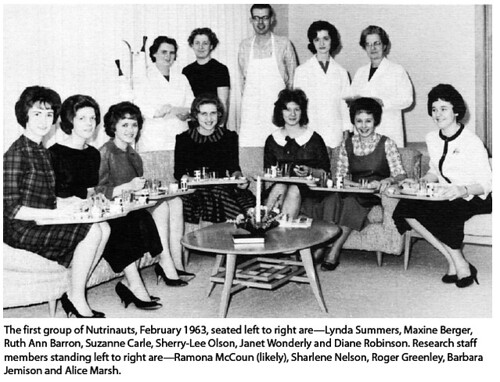
* * *
A nutritional research program, conducted for the past three years through the home economics department at Andrews University, closed in February.
A final report by Alice G. Marsh, professor of home economics, read in part: “This study unifies our existing belief that a lacto-ovo-vegetarian diet can be one of the best diets of the world.”
– “Vegetarian Diet Research Adopted,” The Lake Union Herald, March 14, 1967, p. 23
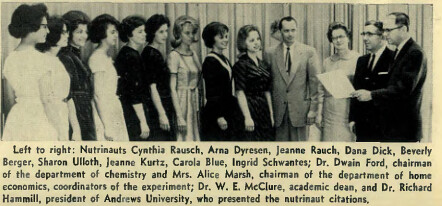
* * *
A grant by [Adventist-founded meat analog manufacturer] Worthington Foods, Inc., of Worthington, Ohio, is enabling the home economics department of Andrews University to continue its research on the supplementary value of various whole protein foods on several generations of animals.
For a number of years the department has done nutrition research with grants from Worthington Foods, Inc. Extension of this year’s study into the second semester was made possible by this new grant.
Of particular interest to the nutrition class the first semester was Worthington’s Chik-Style Fibrotein, a textured soy protein product. Reports Professor Alice Marsh, “The growth of albino laboratory rats from weanling age was excellent with this Fibrotein product as their only source of protein. Their growth equaled that of the control animals on a lacto-ovo-vegetable diet containing the same total amount of protein.”
– “Nutrition Research Continued,” Lake Union Herald, May 9, 1967, p. 16
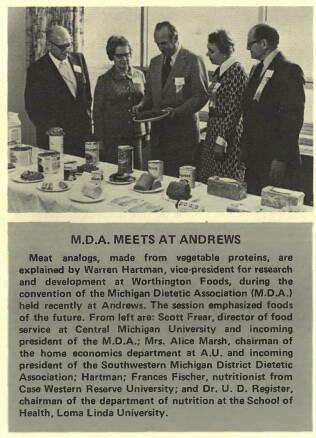
* * *
[Seventh-day Adventist Dietetic Association] President for 1968-1969 is Mrs. Alice G. Marsh, chairman of Home Economics at Andrews University. …
The association is a church-related professional organization with the general purpose of mobilizing its spiritual, educational, and professional influences in support of Christian education.
– “Adventist Dietitians Conduct Fourteenth Annual Convention,” Martha Miller, SDADA Public Relations, Review and Herald, Nov. 21, 1968, p. 21
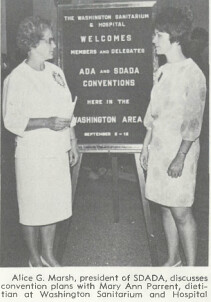
* * *
Direction from the writings of Ellen G. White was utilized in principle and not ignored. “Fruits, grains, and vegetables, prepared in a simple way, free from spice and grease of all kinds, make, with milk or cream, the most healthful diet” [Counsels on Health, p. 115] appears to be an inspired outline of the four food groups — vegetarian style! Yet this plan was given 70 years before a guide called the four food groups was formulated as a reliable basic plan for food selection.
– “More on ‘Johnny Hates Spinach’,” Alice G. Marsh, Review and Herald, Feb. 1, 1973, p. 13
* * *
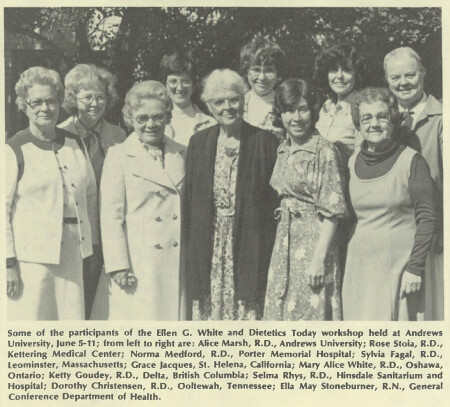
Interest is alive in vegetarian cookery, low cholesterol and low, properly selected fat for everyday meal planning. Trained and up-dated instructors are needed. This type of church work is especially rewarding, for it helps individuals and families.
The course will be presented by Mrs. Alice Marsh, and Mrs. Sylvia Fagal, Seventh-day Adventist Dietetic Association resource dietitian for the Atlantic Union Conference.
– “Home Nutrition Instructor’s Workshop Scheduled at A.U.,” Central Union Reaper, June 16, 1977, p. 14

* * *
Special study will be given as to how the literature evangelists can make their optimum contribution to finishing God’s work now. The desire of Lake Union book evangelists is to work closely with the pastors and church members in the great and final evangelistic effort on planet Earth.
Drs. Fonda Chaffee and Alice Marsh of Andrews University will conduct daily workshops for the literature evangelists’ wives.
– “Annual Literature Evangelists Convention,” John Bernet, Lake Union Herald, Aug. 2, 1977, p. 16
* * *
The Lake Union Conference literature evangelists, their families and leaders met for their annual workshop, August 23 to 27, 1977, at Portage, Wisconsin. Featured guest speakers included R. H. Pierson, president of the General Conference; … and Alice Marsh of Andrews University. The program was balanced with both technical and spiritual instruction. … The aim of the gathering was to sharpen the soul-winning and selling skills of each worker so that Christ’s second coming might be hastened.
– “Literature Evangelists Meet,” Lake Union Herald, Oct. 18, 1977, John Bernet, p. 6
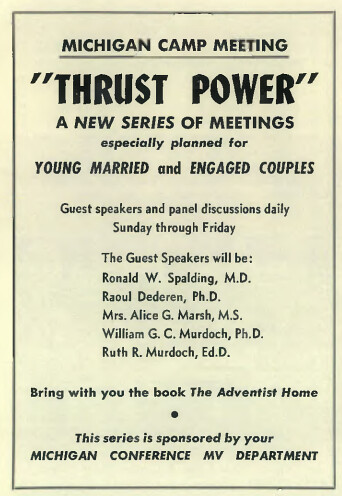
* * *
Every church should be a training school for Christian workers. Its members should be taught how to give Bible readings, how to conduct and teach Sabbath school classes, how best to help the poor and to care for the sick, how to work for the unconverted. There should be schools of health, cooking schools, and classes in various lines of Christian help work. ….“—[Ellen G. White’s] Counsels on Diet and Foods, p. 470.
The newly revised Nutrition Evangelism program has been designed for the very purpose described by Ellen White. Dr. and Mrs. Vollmer, founders of the original Home Nutrition Instructor’s program, sought to use laypeople to share with the community the church’s health and nutrition message. Their training program, from which hundreds of students graduated, included nutrition and food concepts, demonstration techniques, and program planning. Eventually, Andrews University, Loma Linda University, and other colleges and medical institutions also began training lay workers to become home nutrition instructors.
Today volunteer workers trained by… the Registers, Alice Marsh, and many others—conduct nutrition and food-related programs around the world. …
In the Far East, Africa, the Middle East, North, Central, and South America, Europe, Australia, and the islands of the Pacific, Vegetarian Nutrition instructors are directing schools of health, cooking schools, and helpful classes of many kinds. With new programs for the home, the church, and the community, the church is acknowledging the truth of Ellen G. White’s statement: "To teach … the science of healthful living is to do missionary work for the Master."—Counsels on Diet and Foods, p. 476.
– “Nutrition Evangelism: new opportunities for laypeople,” Irma B. Vyhmeister, Adventist Review, June 29, 1984, pp. 20-21
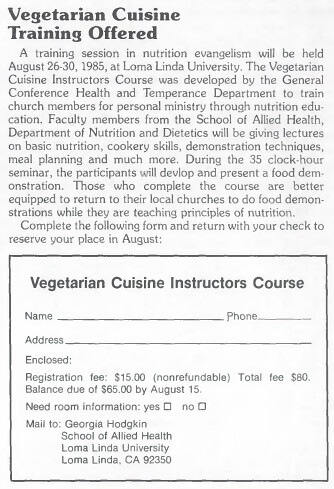
* * *
After Sunday’s devotional by Adventist Review editor William Johnsson, there were health and business discussions with G. Gordon Hadley, MD, Alice Marsh, and Don Robinson. A dietitian, Dr. Marsh, was spearheading the "Adventist Advantage,” adjunct to a bone density study being conducted in Michigan the past ten years.
– “Retirees Hold Four-Day Convention,” Southwestern Union Record, Aug. 8, 1986, P. 12
* * *
A diet containing 95 mg of protein a day—not an unusual amount for American meat eaters—will cause a daily calcium loss of 26 mg, experts say. Even an excess of bean protein or vegetable protein can cause a calcium loss, says [Keith I.] Block.
Scientists are not exactly sure why this loss occurs, but some believe it may be related to the high concentration of acid—the end product of meat digestion—which the body tries to neutralize by dissolving calcium from the bones.
Another theory is that animal protein in particular is high in sulfur-containing amino acids. Such a high concentration of sulfur creates a greater demand for calcium to keep the blood neutralized, said Alice G. Marsh, a registered dietitian and professor emeritus in the department of home economics at Andrews University, a Seventh-day Adventist university in Berrien Springs, Mich.
Besides having a higher sulfur level in their bodies, people who eat red meat probably will have a greater amount of phosphorus, Marsh said. And scientists also theorize that a proper calcium-phosphorus ratio is just as important as adequate calcium intake. …
Vegetarians also have the edge when it comes to preventing osteoporosis, according to studies Marsh conducted in Michigan. In one study reported in February 1980, Marsh monitored the bone marrow density of about 2,000 women. Some who had been lacto-ovo vegetarians for at least 20 years were closely paired with nonvegetarian women in such characteristics as height, weight, age, right-handedness, race and environment.
The results? “We found that vegetarians, upon aging, lost 18 percent of bone mineral,” Marsh said. The nonvegetarians, in contrast, lost 35 percent of bone mass.
– “The Calcium Hoopla: Are You Being Misled?” Carol M. Cain, Vegetarian Times, May 1987, p. 49
* * *
Charlotte Hamlin (professor, public health nutrition), Thelma B. Harris (food editor/columnist, cookbook author, cooking schools), Dr. Alice G. Marsh (research/teaching), Dr. Irma B. Vyhmeister (dietician, professor, administrator), of the Lake Union, and 10 other people were recognized for more than 20 years in outstanding service in education and health outreach at an awards banquet during the Second International Congress on Adventist Nutrition.
This conference focused on current nutrition issues, vegetarian dietary practices at homes, schools and public institutions, health ministry, research and how science is confirming the SDA diet.
– “Health Advocates Honored,” Lake Union Herald, Nov. 1992, p.12
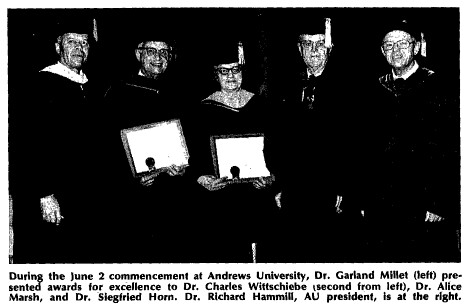
Connie Metcalf: Reviewer for the ADA’s 1988 vegetarian position paper; vegetarian for health and environmental reasons at the time
I emailed Metcalf to ask how she was selected to review this paper. She responded, “I believe I called ADA looking for the latest vegetarian info, they asked if I personally was vegetarian, and then asked if I would be a reviewer as I was an RD and a vegetarian.”
Patricia Mutch: Reviewer for the ADA’s 1988 vegetarian position paper; Seventh-day Adventist vegetarian
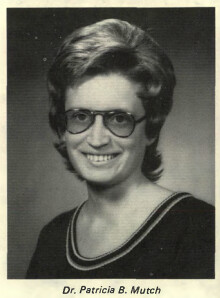
Patricia Mutch began her nutrition career in early 1960s by transporting the feces, urine and used menstrual pads of vegetarian Adventist teenagers to the lab of her future husband, for a study that Adventist dietitian Alice Marsh was orchestrating to test the nutritional qualities of God’s preferred diet (whole-foods-based vegetarianism). Marsh had brought Mutch, then Patricia Black, to Andrews University by promising her a role in the project, nicknamed “Operation Nutrinaut.”
Mutch earned her bachelor’s degree in food and nutrition at Andrews and did a dietetic internship at Loma Linda University. Mutch later became a professor of nutrition at Andrews, and eventually their Vice President of Academic Affairs.
Not long after first working with Marsh, Mutch got active in the Seventh-day Adventist Dietetic Association, becoming their secretary in 1969. In 1977, Mutch was simultaneously President of both the Seventh-day Adventist Dietetic Association and the Michigan Dietetic Association.
Mutch and Marsh wrote the 30-page booklet Low fat or no fat: how prudent is prudent? together, which Andrews University Press published in 1978. They were both “Nutrition Evangelists,” teaching nutrition workshops about “presenting correct nutritional principles to the lay public,” for ministers and anyone else who wanted to bring Ellen G. White’s health principles to the community. Mutch wrote a book related to this called Christian hospitality made easy: Seminar leader’s guide, which was published in 1987.
Marsh and Mutch were presenters at 1987’s First International Congress on Vegetarian Nutrition, which Kathleen Keen Zolber, Patricia Johnston, Kenneth Burke and a few other Loma Linda University star Adventist dietitians organized. At the Congress, Mutch spoke about food guides for adult vegetarians. Mutch and Johnston (a reviewer for the ADA’s 1993 vegetarian position paper) edited all of the Congress’s presentations into a book.
The Seventh-day Adventist Dietetic Association gave Mutch a distinguished service award in 1988, the same year she reviewed the American Dietetic Association’s vegetarian position paper.
The Patricia B. Mutch Nutrition Resource Center, housed in the Nutrition Department of Marsh Hall at Andrews University, was dedicated on March 27, 1996. It contains newsletters, books and fact sheets on vegetarian nutrition.
Patricia Mutch on Dietetics and Ellen G. White
Aided by a $10,000 grant from [Adventist analog meat maker] Worthington Foods, Andrews University is adding a new dietetics curriculum. Richard Hammill, president of Andrews, received the check at a brief ceremony in Worthington, Ohio.
The new program of study will shorten the time required by the student to finish professional study in dietetics. This new coordinated program places educational emphasis on the use of nonmeat proteins. With the rapidly increasing demand for vegetable-protein foods, Worthington and Miles Laboratories readily agreed to support such an educational venture by Andrews. …
Students successfully completing the course of study will receive a Bachelor of Science degree and become a member of the American Dietetics Association. Dr. Hammill stated that Patricia Mutch, Ph.D., R.D., will be the program director. Alice Marsh, Sc.D., R.D., is chairman of the Department of Home Economics.
– “$10,000 Grant Paves Way for AU Dietetic Program,” Review and Herald, July 18, 1974, p. 19
* * *
The importance of diet during pregnancy is not a new idea to students of the Scriptures and the counsels of Ellen G. White. “It is an error generally committed to make no difference in the life of a woman previous to the birth of her children… . Great changes are going on in her system. It requires a greater amount of blood, and therefore an increase of food of the most nourishing quality to convert into blood. Unless she has an abundant supply of nutritious food, she cannot retain her physical strength, and her offspring is robbed of vitality.” [Ellen G. White, Testimonies, vol. 2, pp. 381-383]
– “The Best Possible Diet,” Patricia B. Mutch, Review and Herald, Aug. 15, 1974, p. 16
* * *

“The way to a man’s heart is through his stomach,” says the familiar proverb. 1977 finds the church applying this sage advice to the physical and spiritual health of its members and to evangelistic outreach to the community through various methods of nutrition education, including cooking schools. This emphasis on nutrition can provide us with unusual opportunities, because nutrition is a topic of universal interest. However, sometimes we find our efforts to improve the diet of others have disappointing results. Many members and potential members have been “turned off” by nutrition advice and education. Ellen G. White in Testimonies, volume 2, pages 384-387, describes the unfortunate situation that may arise when unwise statements or efforts concerning health reform are made. What can be done to make nutrition education more effective and avoid alienating those we seek to reach? …
We need to teach that good health through good diet promotes spiritual growth because it allows us to have a clear mind with which to communicate with God, and a healthy body with which to serve Him. But what we eat or fail to eat doesn’t save us. A fundamental part of all health education must be a component that directs our minds to the saving grace of Christ, inviting us to surrender our will and appetite to Him. When that relationship is achieved, changes in diet, though slow, will come willingly out of love for Him. But changes in diet without that relationship are of no spiritual value and may even serve to drive away those who are interested. …
Furthermore, we observe, from the definition, that true health is more than not being sick. It is an optimal state of being. This is in harmony with God’s plan for the restoration of man (John 10:10) and with inspired counsel: “In teaching health principles, keep before the mind the great object of reform—that its purpose is to secure the highest development of body and mind and soul."—Counsels on Diet and Foods, p. 457. …
In this respect, we are counseled by Ellen White to educate in a progressive, step-by-step approach. Often in public-nutrition efforts, we go too quickly for our listeners. If we have grown up with health reform, a healthful diet may seem simple and obvious to us. But our hearers have grown up differently. Food habits are deeply ingrained in family custom and culture, and change will come slowly. "If you err, let it not be in getting as far from the people as possible, for then you cut the thread of your influence and can do them no good."— Ibid., p. 211. We must always bear in mind how difficult change is, both for the individual with established taste preferences, and for the family accustomed to their usual meal patterns.
The fascinating topic of nutrition can be used with great effectiveness to reach and help people spiritually, if the concepts discussed above are used. Patience and time must be given to its study and to the changes that will be made. As a major segment of the health-reform message, improving nutrition should continue to be emphasized both within the church and in outreach efforts. We may always appropriately claim the promise in James 1:5, "If any of you lack wisdom, let him ask of God, that giveth to all men liberally, and upbraideth not.”
– “Making Nutrition Education Practical,” Patricia B. Mutch, The Ministry, Oct. 1977, pp. 30-33

* * *
Pat Mutch reported upon a search by the White Estate for reference Mrs. White made concerning the use of fat in a normal diet. The following are excerpts from a report by Arthur White: “In dietary matters Ellen White did not call for a fat-free diet. Nor did she call for a diet that was free from the use of any so-called free fat. In 1890, in a statement from Counsels on Diet and Foods, page 355, she advocates a diet of fruits, grains, and vegetables, prepared in a simple way, free from spice and grease of all kinds, with milk or cream, which she declares to be the most healthful diet. This undercuts the contention that when Ellen White uses the term ‘grease’ she is speaking of fats of all kinds, because in this one sentence Ellen White condemns grease but not cream.
"Some maintain that in Ellen White’s statements, where she speaks of the oil as eaten in the olive, she implies that the free oil should not be used. This is not sustained by fact. In the sales slips from the sanitarium store there are records listing the purchase, on several occasions, of olive oil. The sales slips also list the purchase of cooking oil. As to meat substitutes prepared by our food factories, while condemned by some advocating the fat-free diet, consistently through the years, covered by the sales slips, we find frequent purchases of nut cero and nut loaf from the sanitarium store. Another item that appears consistently is butter. Butter was used in the White home in cooking but was not placed on the table.
"It is a misuse of E. G. White’s writings to maintain that they would support the proposition that the dietary program the Lord has placed before us is one that contains no free fat. The peril of such teachings is that some who incline to go to some extremes will follow a dietary program which in time will lead to a reaction and possibly create a negative attitude toward true health reform.”
The Seventh-day Adventist Dietetic Association voted to enthusiastically support the General Conference Nutrition Task Force recommendations for treating cardiovascular patients. The membership did not support any diet that reduced fat and protein to 10 percent each of total calories, because scientific evidence does not support this theory for the general population and nutritional requirements cannot be met in all populations on this regimen. The writings of Ellen G. White do not call for such a severe reduction in fat and protein, and the diet is impractical and unpalatable.
– “Fat-Free Diet: As Discussed at Seventh-day Adventist Dietetic Association’s Annual Meeting,” Rose Stoia, Columbia Union Visitor Review, Dec. 29, 1977, p. 16k
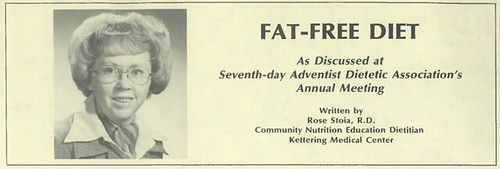
* * *
An interview with Mrs. Grace Jacques, granddaughter of Ellen G. White, conducted by Dr. Patricia B. Mutch at the workshop ‘Ellen G. White and Dietetics,’ sponsored by the Department of Home Economics, Andrews University, June 8, 1978.
Grace White Jacques was born in 1900 and was 15 when her grandmother died. The information recorded here reflects what she observed in Ellen G. White’s Home Elmshaven during the last years of Mrs. White’s life. …
Patricia Mutch: Did you eat bread just plain? Did you put margarine or cream, or what did you put on bread?
Jacques: Well, we loved cream, which is all out of date now, but we liked it. …
Patricia Mutch: [The Ellen G. White household] didn’t use butter, as I understand.
Jacques: Those that wanted it would go to the pantry and get it—if they were particularly hungry for butter.
Patricia Mutch: There was butter?
Jacques: Yes. She wasn’t iron-clad. I mean, it wasn’t the iron curtain like it is in Russia.
Patricia Mutch: So there was butter in the pantry?
– “Dinner at Elmshaven,” 1978
* * *
More than 80 dietitians and nutritionists from the United States, Canada, and Puerto Rico met September 22-25 at the International Hotel in New Orleans for the 24th annual meeting of the Seventh-day Adventist Dietetic Association. … “We, as Seventh-day Adventists, are the most blessed people upon the face of the earth, for God has entrusted us with a message, of which health is a part, to give to the world to prepare a people for His soon return. The giving of this message can only be done fully by a people with well bodies and sound minds,” states Robert H. Hines, R.D., director of Food Services at Oakwood College.
Patricia Mutch, Ph. D., R.D., outgoing president of the association, presided over the meeting.
– “SDA Dietitians Hold 24th Convention,” Southern Tidings, Dec. 1978, p. 19
* * *
Taught by Viola Lutz, and Pat Mutch, both faculty members at Andrews, the workshop will include the principles of healthful vegetarian cookery, how to demonstrate recipes and teach others healthful cookery, and how to witness through cooking classes. …
Ellen G. White and Nutrition Today is to be directed by Dr. Mutch and Ronald Graybill, associate secretary of the Ellen G. White Estate. This workshop has been designed for all persons interested in applying Ellen White’s counsels on diet and foods to today’s nutritional choices.
The workshop provides an opportunity to explore in-depth the nutrition counsels of Ellen G. White as they relate to history, and to research knowledge today.
– “Home Economics Department Offers Workshops,” Lake Union Herald, June 7, 1983, p. 2
* * *
Three nutrition evangelism trainers were preceptored at a workshop sponsored by the Michigan Conference and Andrews University, June 8-13 at Adelphian Academy in Holly, Michigan. …
Irma B. Vyhmeister and Patricia Mutch, dietitians, co-directed the workshop. …
The courses included lectures on nutrition and foods, group activities, demonstration techniques, public speaking, seminars about nutrition and the gift of prophecy, team leadership and the planning of nutrition programs. …
The interaction of the two workshops pointed to many possibilities of nutrition evangelism teams in outreach programs for the church, the home and the community that highlight good nutrition and a healthful lifestyle. Students remarked: “The spiritual overtones throughout the program were inspirational.”
“We need more of these types of training for our local churches.”
Dietitians, nutritionists and home economists interested in a preceptorship to become nutrition evangelism trainers and church members who would like to be trained in 1987 should contact John Swanson, Michigan Conference of Seventh-day Adventists…
– “Michigan uses a new approach to vegetarian workshops,” Lake Union Herald, Sept. 9, 1986, p. 6
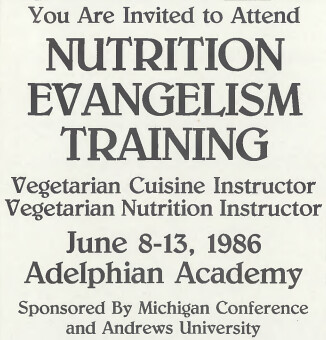
* * *
Soul winning can take on many forms. One of the most important ingredients that is often overlooked is that of using our homes for the Lord. The Caring Christian Women of the Columbia Seventh-day Adventist Church recently sponsored a Hospitality Ministries Seminar, attended by 60 individuals from across the Iowa-Missouri Conference. Patricia Mutch, Ph.D. and Stella Greig, M.A. of Andrews University, were the instructors. …
Pat Mutch and Stella Greig have conducted this Hospitality Ministries Seminar several times in the Berrien Springs, Michigan area and are developing it for use by the General Conference in connection with the Harvest 90 outreach.
– “Hospitality Seminar,” Outlook, Jan. 1987, p. 27
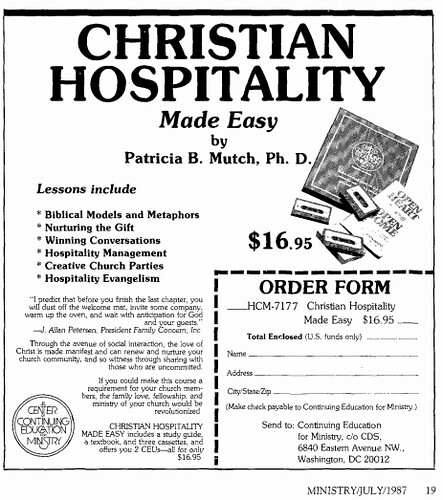
* * *
The Seventh-day Adventist Dietetic Association presented its Distinguished Service Award October 4, 1988, to Patricia Mutch, professor of nutrition. The award recognizes exemplary contribution to SDA dietetics through outstanding leadership in wide-ranging educational endeavors and research. Dr. Mutch was cited for her involvement with the First International Vegetarian Congress held in 1987, for service in several dietetic associations and for leadership at Andrews.
– “Andrews University news notes,” Lake Union Herald, Mar. 1989, p. 21
* * *
1. Ron Graybill has offered some cogent suggestions for resolving problems encountered in [Ellen G. White’s divinely] inspired writings; answer the questions:
a. Do I really understand the meaning, intent, and importance of the inspired writer’s statements?
b. Do I really understand the evidence which is in apparent conflict with the inspired statement?
c. Might I reasonably expect more evidence to be forthcoming from further study, research, or divine illumination?
d. Can the two sets of data be harmonized?
e. Can the issue be left unresolved?
f. Should I communicate my conclusions to others?
g. How can I communicate my conclusions to others in a way which will increase their understanding of truth and build their faith?
2. Pat Mutch made four suggestions: Our primary responsibility should be to
a. Gain as much knowledge of inspiration and science as we possibly can.
b. Apply the principles of health reform to our personal lives in a sensible and balanced manner.
c. Use scientific evidence correctly, in a manner devoid of (1) Sensationalism, and (2) Distortion
d. Recognize that: (1) Our understanding is finite (2) The Holy Spirit will give us the knowledge and strength to live in harmony with His will for us (Cf. John 7:17), if we trust and follow His guidance.
– “Ellen G. White and Science: The ‘Problem’ Statements,” Roger W. Coon, May 29, 1996
U. D. Register: Reviewer for the ADA’s 1988 position paper on a vegetarian diet, and probable contributor to the 1980 paper; Seventh-day Adventist vegetarian
U. D. Register was an Adventist biochemist who enjoyed using science to prove that Adventist prophet Ellen G. White’s holy visions were nutritionally accurate. In one study, he put rats on a nutritionally poor diet to see if they would turn to alcoholic drink, since Ellen White once said that poorly nourished humans were more prone to alcoholism. When some of the rats didn’t conform to Ellen G. White’s vision, Register sweetened their alcohol in order to train them to drink it. Register and his research team insisted this wasn’t cheating because when the rats drinking the sweetened alcohol were switched to an Adventist-approved, whole-foods-based vegetarian diet, they drank less alcohol.
One of Register’s missions was to improve the image of a whole-foods-based vegetarian diet, as Ellen G. White said God told her in a vision that it was the best diet for humankind. Many credit Register with persuading the American Dietetic Association that vegetarianism could be nutritionally adequate.
The ADA’s 1988 position paper cited a paper Register wrote with Adventists Irma B. Vyhmeister and Lydia Sonnenberg, “Safe vegetarian diets for children,” Pediatr Clin North Am 24:203, 1977.
For more on Register, see History of the American Dietetic Association’s Vegetarian Position Papers, Part One and Part Two.
Kathleen Keen Zolber: Reviewer for the ADA’s 1988 vegetarian position paper, and probable contributor to the ADA’s 1980 vegetarian position paper; Seventh-day Adventist vegetarian
Kathleen Keen Zolber was The Congress Program Chairman of the first International Congress on Vegetarian Nutrition. She was a member of the Seventh-day Adventist Dietetic Association and contributed to their publications Everyday Nutrition for Your Family and It’s Your World Vegetarian Cookbook, both of which cited Adventist prophet Ellen G. White as a source of nutritional wisdom. She was president of the American Dietetic Association in 1982, which some Adventists saw as a vindication of vegetarianism and the Adventist health message, which the American Dietetic Association had disregarded for so long. After an Adventist organization awarded Zolber “Woman of the Year,” The Adventist Woman wrote:
As an educator, researcher, scholar, manager, and leader, Kathleen Zolber has influenced her profession and supported her church in a life-long career in nutrition and dietetics. … Her faith and values as an Adventist Christian have permeated her professional life. Her professional expertise has enriched her service to her church.
– “1985 Women of the Year: Nutritionist, Bible worker, and missionary honored in New Orleans for lives of service,” The Adventist Woman, July/Aug., 1985, p. 5
For more on Zolber, see History of the American Dietetic Association’s Vegetarian Position Papers, Part One and Part Two.
The next entry in this series will look at the ADA’s 1993 position paper on a vegetarian diet.